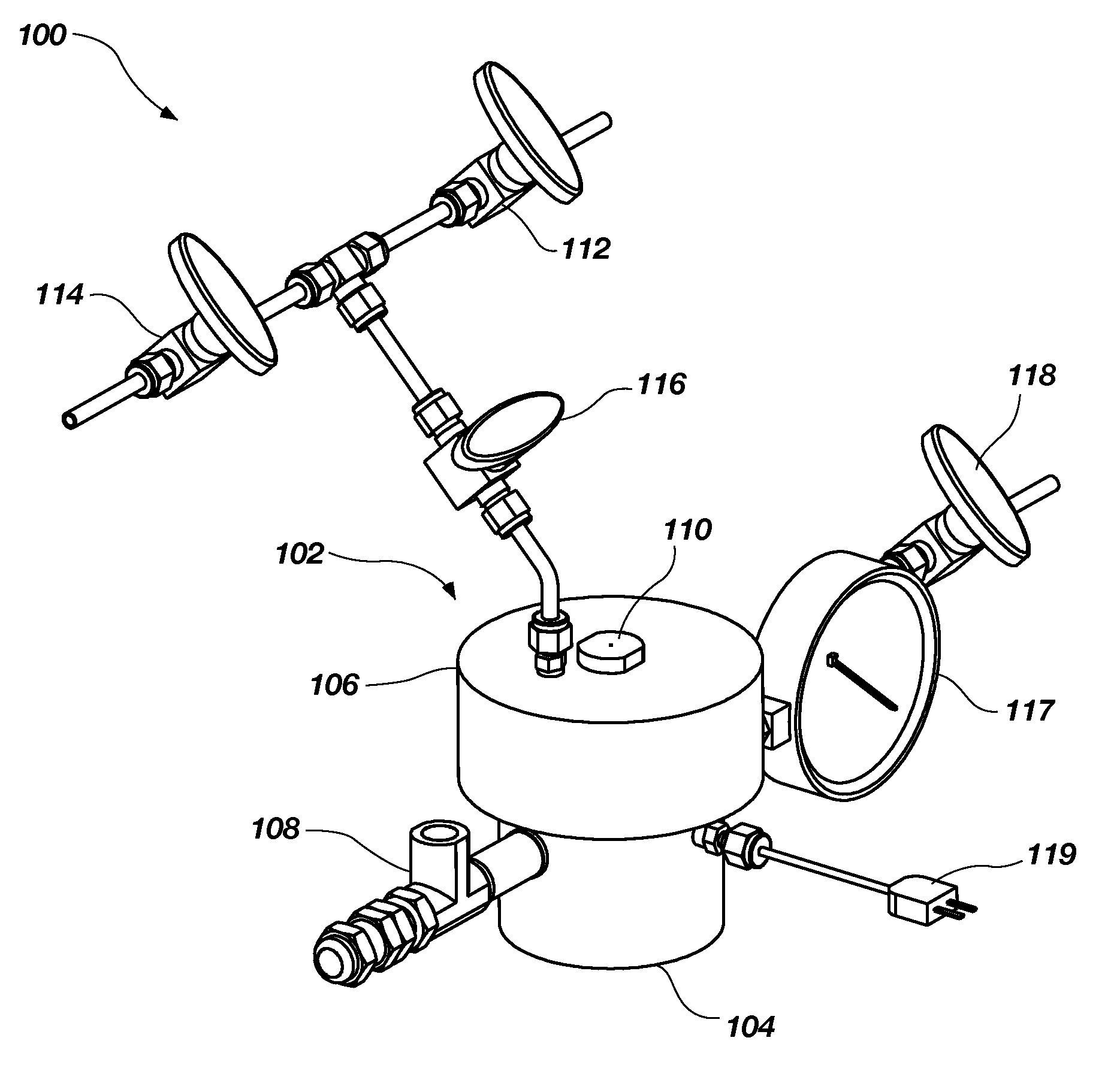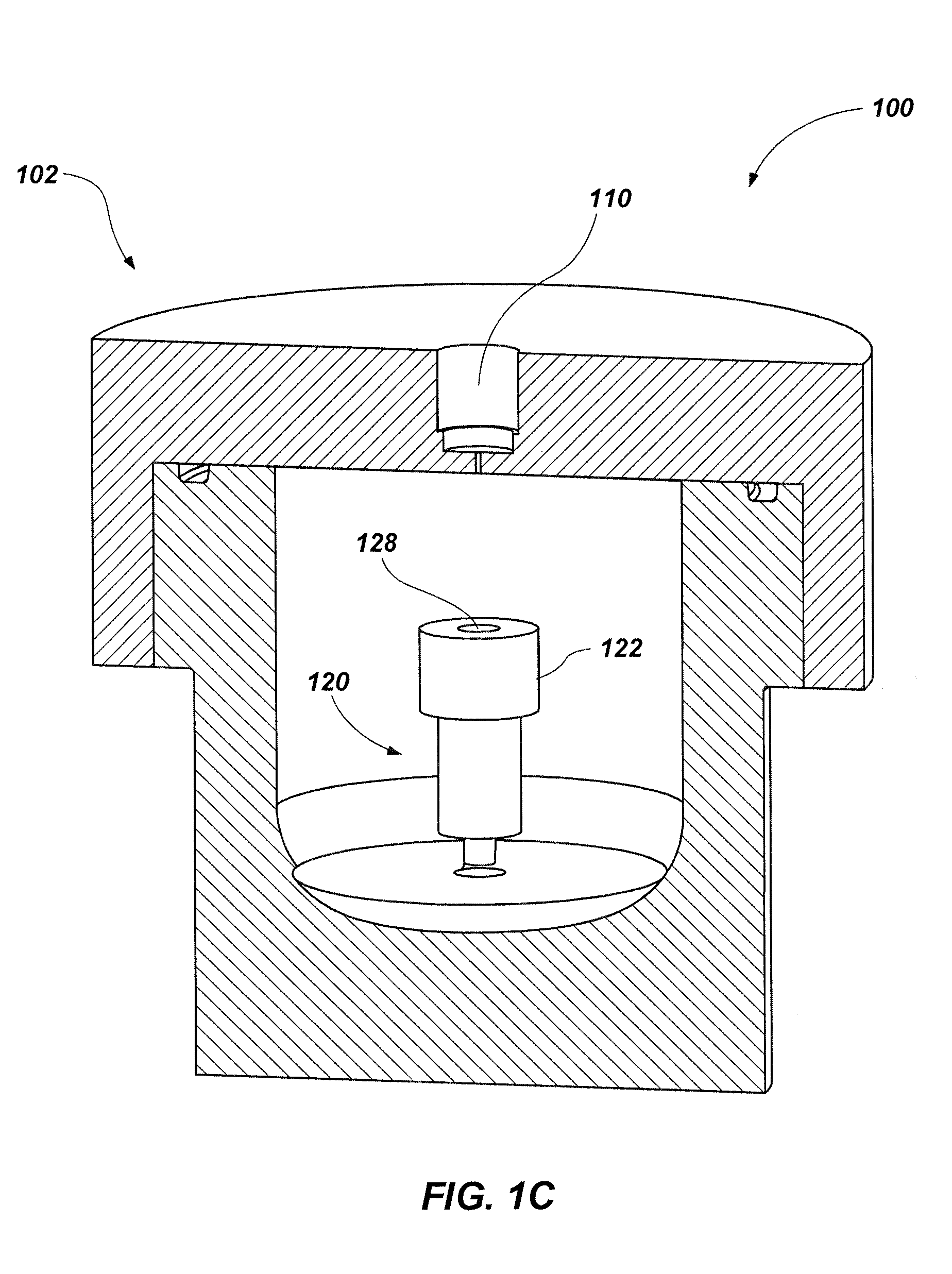Methods and systems for producing hydrogen and system for producing power
a technology of applied in the direction of liquid gas reaction of thin film type, gas-gas reaction process, explosives, etc., can solve the problems of insufficient hydrogen for portable hydrogen and power generation, insufficient amount of hydrogen for liquid hydrogen for most consumer applications, and inability to meet the requirements of high-efficiency production and us
- Summary
- Abstract
- Description
- Claims
- Application Information
AI Technical Summary
Benefits of technology
Problems solved by technology
Method used
Image
Examples
example 1
[0038]Ammonia borane powder, which is commercially available from RTI International (Research Triangle Park, N.C.) or Sigma-Aldrich Co. (St. Louis, MO) was weighed in amounts in a range of from about 1 mg to about 30 mg in stainless steel or ceramic pans, and was reacted with from about one (1) μL to about thirty (30) μL of an oxidizer in a 0.20 L stainless steel reactor. The oxidizer included a mixture of hydrogen peroxide and water at a ratio of 1:1 (i.e., 50% hydrogen peroxide).
[0039]About twenty-two (22) mg of ammonia borane powder was reacted with various amounts of 50% hydrogen peroxide in a system similar to or identical to the system 100 shown in FIGS. 1A through 1C. The reactions were performed using a ratio of the 50% hydrogen peroxide to the ammonia borane of between about six-tenths (0.6) and about one and three-tenths (1.3), which provided a hydrogen percentage of between about 5 wt % and about 9 wt %.
[0040]During the reaction, the temperature within the reactors was ab...
example 2
[0045]Theoretical results for the weight percent of hydrogen produced by reacting ammonia borane with an oxidizer including water and hydrogen at a ratio of 1:1 (50% hydrogen peroxide by volume) and at a ratio of 20:7 (35% hydrogen peroxide by volume) were obtained executing the computer program Chemical Equilibrium with Applications, which is available from NASA (Washington, D.C.). The theoretical hydrogen weight percentage was generated using ratios of the oxidizer to ammonia borane (“OF ratio”) between about 0.1 to about 2.58. The theoretical hydrogen weight percentages (wt %) generated using the Chemical Equilibrium with Application program are shown in FIG. 4.
[0046]Under certain conditions, reacting ammonia borane, water and hydrogen peroxide may provide a mass fraction of hydrogen of over 18%. The thermal decomposition of ammonia borane may produce a substantially increased hydrogen yield in comparison to the reactions of ammonia borane with water and hydrogen peroxide. Utiliz...
example 3
[0047]About twenty-two (22) mg of ammonia borane powder, which is commercially available from RTI International (Research Triangle Park, N.C.) Sigma-Aldrich Co. (St. Louis, MO), was placed in reactors of a system similar or identical to the reactor shown in FIGS. 1A-1C. A 50% hydrogen peroxide solution was manually injected into the reactor to introduce the hydrogen peroxide to the ammonia borane.
[0048]FIG. 5 is a plot illustrating the hydrogen weight percentage (wt %) produced by reacting the 50% hydrogen peroxide with ammonia borane. The reactions were performed using a ratio of 50% hydrogen peroxide to an ammonia borane (“OF ratio”) of about 0.8. Three types of sample containers were used to perform the reactions, one including a ceramic body and a stainless steel lid (which is represented in FIG. 5 as ●), another including a ceramic body (or “pan”) and a ceramic lid (which is represented in FIG. 5 as Δ), and a third including a stainless steel body and a stainless steel lid (whi...
PUM
| Property | Measurement | Unit |
|---|---|---|
| temperature | aaaaa | aaaaa |
| depth | aaaaa | aaaaa |
| depth | aaaaa | aaaaa |
Abstract
Description
Claims
Application Information
 Login to View More
Login to View More - R&D
- Intellectual Property
- Life Sciences
- Materials
- Tech Scout
- Unparalleled Data Quality
- Higher Quality Content
- 60% Fewer Hallucinations
Browse by: Latest US Patents, China's latest patents, Technical Efficacy Thesaurus, Application Domain, Technology Topic, Popular Technical Reports.
© 2025 PatSnap. All rights reserved.Legal|Privacy policy|Modern Slavery Act Transparency Statement|Sitemap|About US| Contact US: help@patsnap.com



